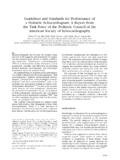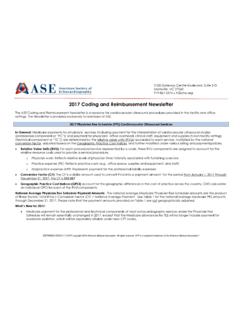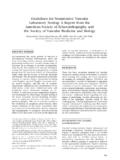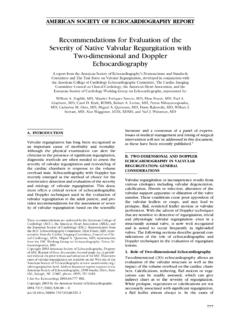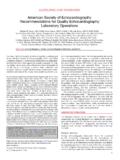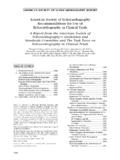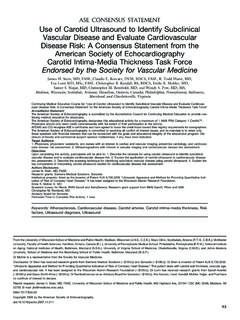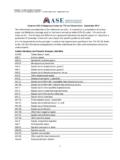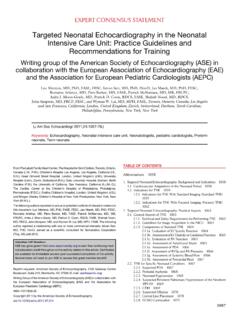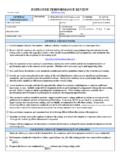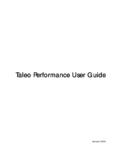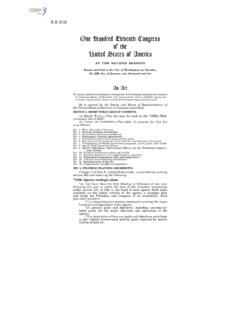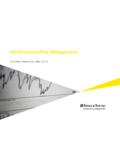Transcription of Guidelines for the Cardiac Sonographer in the …
1 Guidelines AND STANDARDSG uidelines for the Cardiac Sonographer in thePerformance of Contrast Echocardiography:A Focused update from the American Societyof EchocardiographyThomas R. Porter, MD, FASE (Chair), Sahar Abdelmoneim, MD, J. Todd Belcik, BS, RCS, RDCS, FASE,Marti L. McCulloch, MBA, RDCS, FASE, Sharon L. Mulvagh, MD, FASE, Joan J. Olson, BS, RDCS, RVT, FASE,Charlene Porcelli, BS, RDCS, RDMS, FASE, Jeane M. Tsutsui, MD, and Kevin Wei, MD, FASE,Omaha,Nebraska; Rochester, Minnesota; Portland, Oregon; Houston, Texas; Charleston, South Carolina; S~ao Paulo, Brazil(J Am Soc Echocardiogr 2014;27:797-810.)Keywords:Echocardiograp hy, Sonographer , Contrast, ImagingTABLE OF CONTENTSI. update on Knowledge of Ultrasound Physics and Instrumentation 798II. update on Contrast Administration Policy and EstablishingIntravenous Access 798 III. update on How and When to Perform ContrastEchocardiography 799LV Ejection Fraction and Regional Wall Motion Assessment 800 Hypertrophic Cardiomyopathy, Apical Variant 801LV Noncompaction 801LV Thrombus and Intracardiac Mass Evaluation 801 LVAneurysm versus Pseudoaneurysm 801 Other Less Common Apical Abnormalities 801 Emergency Department CP Evaluation 802IV.
2 update on Contrast Injection and Infusion Safety 802 Anaphylactic Reaction Response Protocols 803 Use of Ultrasound Contrast Agents in PHT 803 Safety in Patients with Patent Foramen Ovale and Congenital HeartDiseases 803V. Key Components for Optimizing the Contrast Examination 804VI. Saline Contrast Optimization for Transthoracic and TransesophagealRight-to-Left Shunt Detection 804 VII. Future Contrast Developments for the Sonographer 805 VIII. Recommended Initiatives 805 Notice and Disclaimer 806 Supplementary Data 806 References 806 Appendix 808In 2001, the American Society of Echocardiography (ASE) pub-lished a position paper that provided Guidelines for the performanceof contrast echocardiography by a paper focusedon the Sonographer s role in four specific areas: understanding ofmicrobubble physics and ultrasound instrumentation, recognitionof indications for the use of contrast media, establishment of intrave-nous (IV) access privileges if necessary, and development of writtenpolicies for contrast agent infusion or is the purpose ofthis paper to update sonographers on developments in these fourareas and to provide useful tips that assist in optimizing the use ofcontrast media in an echocardiography laboratory.
3 This will includethe optimal use of both saline and left-sided contrast media, as wellFrom University of Nebraska Medical Center, Omaha, Nebraska ( , );Mayo Clinic, Rochester, Minnesota ( , ); Oregon Health & ScienceUniversity, Portland, Oregon ( , ); Houston, Texas ( ); MedicalUniversity of South Carolina, Charleston, South Carolina ( ); Fleury Group,S~ao Paulo, Brazil ( ).The following authors reported no actual or potential conflicts of interest in relationto this document: Sahar Abdelmoneim, MD, J. Todd Belcik, RCS, RDCS, FASE,Marti L. McCulloch, MBA, RDCS, FASE, Joan J. Olson, BS, RDCS, RVT, FASE,Charlene Porcelli, BS, RDCS, RDMS, FASE, Jeane M. Tsutsui, MD, and KevinWei, MD, FASE. The following authors reported relationships with one or morecommercial interests: Sharon L. Mulvagh, MD, FASE, receives research supportfrom Lantheus Medical Imaging and Astellas Pharma.
4 Thomas R. Porter, MD,FASE, has received research support from Philips Research North America, GEHealthcare, Astellas Pharma, and Lantheus Medical ASE Members:The ASE has gone green! earn free continuingmedical education credit through an online activity related to this are available for immediate access upon successful completionof the activity. Nonmembers will need to join the ASE to access this greatmember benefit!Reprint requests: American Society of Echocardiography, 2100 Gateway CentreBoulevard, Suite 310, Morrisville, NC 27560 2014 by the American Society of safety information and rec-ommended policies for left-sided contrast agent update ON KNOWLEDGEOF ULTRASOUND PHYSICSAND INSTRUMENTATIONS ince the 2001 document,considerable progress has beenmade in the area of improvingthe visualization of a com-mercially available ultrasoundcontrast agent (UCA) for leftventricular (LV) opacification(LVO) and perfusion.
5 Withregard to details on thecomposition of commerciallyavailable microbubbles and mi-crobubble physics, please referto the Contrast Agents and Contrast-Specific UltrasoundImaging sections in the 2008 ASE consensus enhancement for LVOusing low mechanical index(MI) harmonic imaging hasbeen available on all ultrasoundsystems marketed within thepast decade, and real-time verylow MI techniques are availableon nearly all commercially avail-able systems. By definition, very low MI represents values < ,low MI represents values < , intermediate MI represents valuesof to , and high MI is any MI that exceeds The real-timevery low MI techniques permit the enhanced detection of microbub-bles within the LV cavity and myocardialperfusion imaging is not an approved indication for UCAs, thesevery low MI imaging techniques have been used in multiple clinicalstudies to examine perfusion and improve the detection of coronaryartery disease in the emergency department, improve the detection ofcoronary artery disease during stress testing, and improve the diag-nostic evaluation of Cardiac masses.
6 Therefore, sonographers shouldbe familiar with the advantages and drawbacks of each contrast imag-ing method (Table 1) and the physics related to each technique(Figure 1).Pulse-inversion Doppler(originally developed by AdvancedTechnology Laboratories, now used by GE Healthcare, LittleChalfont, United Kingdom) is a tissue cancelation technique thatovercomes motion artifacts by sending multiple pulses of alternatingpolarity into the cavity and myocardium. Although pulse-inversionDoppler provides excellent tissue suppression and high resolutionby receiving only even-order harmonics, there is significant attenua-tion, especially in the basal myocardial segments of apical modulation(originally developed by Philips MedicalSystems, Andover, MA) is a technique that improves the signal-to-noise ratio at very low MIs ( ). This technique is also a multi-pulse cancelation technique, only here, the power, or amplitude, ofeach pulse is varied.
7 The low-power pulses create a linear response,whereas the slightly higher power pulse results in a linear responsefrom tissue but a nonlinear response from microbubbles. The linearresponses from the two different pulses (the amplified low-powerpulse and the slightly higher power pulse) can be subtracted fromeach other. The transducer then only detects the nonlinear behavior,which emanates exclusively from the microbubbles. Power modula-tion also detects fundamental nonlinear behavior but does not havethe resolution and image quality that pulse inversion pulse sequencing(originally developed by SiemensMedical Solutions USA, Mountain View, CA) combines these multi-pulse techniques by interpulse phase and amplitude modulation,which although more complex has the purpose of enhancingnonlinear activity from microbubbles at a low MI and canceling outthe linear responses from tissue.
8 Contrast imaging with each specificpulse-sequence scheme can be used at very low MIs (< ) to assessLVO and myocardial contrast perfusion in real time with excellentspatial resolution. Sonographers should be aware of the variationsin pulse-sequence schemes and use them if available whenevercontrast is required (Table 1). The advantage, compared with B-mode low-MI harmonic imaging (LVO), is that there is better tissuecancelation and enhanced contrast from microbubbles. However,not all vendors have real-time very low MI imaging software available,and in these settings, low-MI (< ) harmonic imaging should document provides instructions on how to set up very low MIreal-time imaging, and the video examples provide specific examplesas well as potential artifacts. The writing group recommends that so-nographers who are just beginning to use UCAs, or who do not havevery low MI imaging software available, start with the low-MI har-monic imaging methods described inTable 1.
9 We recognize that expe-rience is a critical factor in performing any aspect of ultrasoundimaging, and we recommend to all sites that they work with their localcontrast agent representatives to optimize contrast with low-MI imag-ing techniques and with their specific ultrasound vendors on how toeffectively use real-time very low MI imaging update ON CONTRAST ADMINISTRATION POLICY ANDESTABLISHING INTRAVENOUS ACCESSIt is recognized that the establishment of IVaccess remains one of thebiggest obstacles to administering UCAs in clinical echocardiographylaboratories. Because UCAs are critical to improving the detection ofregional wall motion abnormalities and improving the detection ofDoppler signals, it is essential that sonographers work with hospitaladministrations to adopt a contrast program that promotes their usein technically difficult studies. In August 2012, the IntersocietalAccreditation Commission (IAC) officially released the new IAC stan-dards and Guidelines for adult echocardiography require all Cardiac ultrasound systems to have instrumentsettings to enable the optimization of UCAs.
10 The IAC guidelinesrecommend using UCAs for all studies with suboptimal image qualityand require a policy or process to enable alternative imaging for sub-optimal studies. Several large clinically active cardiology programshave put in place policies for UCA use that assist sonographers incomplying with current IAC Guidelines . This update reemphasizesthe 2001 statement that the ASE supports IV training for sonogra-phers in hospital and clinic settings. This training requires knowledgeof aseptic technique, venous anatomy, appropriate sites of access,risks to patients, and hospital approval to perform the technique. ToAbbreviationsAMI= Acute myocardialinfarctionASE= American Society ofEchocardiographyCP= Chest painFDA= US Food and DrugAdministrationIAC= IntersocietalAccreditation CommissionIV= IntravenousLV= Left ventricularLVO= Left ventricularopacificationMI= Mechanical indexPFO= Patent foramen ovalePHT= PulmonaryhypertensionRVSP= Right ventricularsystolic pressureTEE= TransesophagealechocardiographyTTE= TransthoracicechocardiographyUCA= Ultrasound contrastagent798 Porter et alJournal of the American Society of EchocardiographyAugust 2014optimize echocardiographic quality and improve patient care byreducing unnecessary additional procedures, UCAs should be usedwhen indicated, and sonographers deserve full hospital administrativesupport in achieving this IAC mandate.
